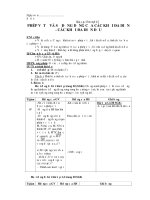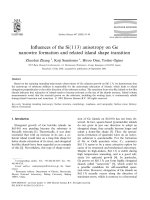1 3 formation pressures
Bạn đang xem bản rút gọn của tài liệu. Xem và tải ngay bản đầy đủ của tài liệu tại đây (505.93 KB, 42 trang )
Network of Excellence in Training
Formation Pressures
© COPYRIGHT 2001, NExT.
All Rights Reserved
Formation Pressures
• Lecture Contents;
– Lecture Objectives,
– Introduction,
– Hydrostatic pressure,
– Pore pressure,
– Overburden pressure,
– Formation fracture gradient,
– Causes of abnormal pressure,
– Geopressure predication.
2
© COPYRIGHT 2001,
.
All Rights Reserved
Formation Pressures
• Lecture Objectives;
– At the end of this course YOU will be able to:
• Define various formation pressures including:
– Hydrostatic pressure,
– Overburden pressure,
– Pore pressure,
– Formation fracture gradient.
• Use various techniques and methods to compute them,
• Plan well pressure profile applying safety margin,
• Understand how these pressures were generated,
• Describe some of the prediction techniques.
3
© COPYRIGHT 2001,
.
All Rights Reserved
Introduction
• The Study of Formation Pressures (Overburden,
Pore and Fracture Gradients) Will assist in the
Following:
– Casing Design,
– Avoid Stuck Pipe,
– Well Control,
– ROP,
– Mud Weight Design,
– Overpressure Zones.
4
© COPYRIGHT 2001,
.
All Rights Reserved
Introduction
• Graphic Presentation of Various Pressures:
0500 1000 -
2000 -
en
en
di
t
500
ra
G
250
rd
bu
0
t
ien
ad
Gr
re
nt
4000 4500 -
tu
ac
Fr
die
ient
a
Gr
ud
rad
3500 -
M
3000 -
r
ve
O
2500 -
eG
Por
Depth (m)
1500 -
1000
Pressure (kg/cm2)
1250
5
© COPYRIGHT 2001,
.
All Rights Reserved
Hydrostatic Pressure
• Definitions;
– It is defined as the pressure exerted by column of fluid,
– This pressure is function of average fluid density and the
vertical height or depth of fluid column,
– Mathematically it is expressed as:
HP g
.f . D
HP
g
f
D
=
=
=
=
Hydrostatic pressure. (psi),
Gravitational acceleration,
Average fluid density. (ppg),
True vertical depth. (ft)
6
© COPYRIGHT 2001,
.
All Rights Reserved
Hydrostatic Pressure
• Definitions;
– Also it is expressed as:
• HP (psi) = 0.052 (psi/ft) x TVD (ft) x MW (ppg), or
• HP (Kg/cm2) = {TVD (m) x MW (kg/l)} / 10
• 0.052 psi/ft is constant and obtained by:
1 ft
1 ft
1 ft
144 sq in
Container = 7.48 gal/ft3 / 144 in2 = 0.052 psi/ft
7
© COPYRIGHT 2001,
.
All Rights Reserved
Hydrostatic Pressure
• Definitions;
– Hydrostatic pressure gradient is given by:
• HG = HP / D,
– By converting wellbore pressure to gradient relative to to
a fixed datum (seabed or msl);
• It is possible to compare pore, fracture, overburden
pressure, MW and ECD on the same basis,
• Also gradient assists in plotting of these pressures.
8
© COPYRIGHT 2001,
.
All Rights Reserved
Pore Pressure
• Definition:
• It is defined as the pressure acting on the fluids in the pore
spaces of the rock. It is related to fluid salinity.
• Normal Pore Pressure:
– Normal pore pressure is equal to the hydrostatic pressure of a
column of formation fluid extending from the surface to the
subsurface formation,
– The magnitude of normal pore pressure varies with
concentration of dissolved salts, type of fluid, gas present
and temperature gradient.
9
© COPYRIGHT 2001,
.
All Rights Reserved
Pore Pressure
• Definitions;
– Abnormal Pore Pressure:
• It is defined as any pore pressure that is greater than the
hydrostatic pressure of the formation water occupying the
pore space.
• The causes of abnormal pressure is attributed to the
combination of various geological, geochemical,
geothermal and mechanical events.
10
© COPYRIGHT 2001,
.
All Rights Reserved
Pore Pressure
• Definitions;
– Subnormal Pore Pressure:
• It is defined as any pore pressure that is less than the
corresponding pore fluid hydrostatic pressure at a given
depth,
• Occurs less frequent than abnormal pressures. Might have
natural causes related to the stratigraphic, tectonic and
geochemical history of an area.
11
© COPYRIGHT 2001,
.
All Rights Reserved
Pore Pressure
• Definitions;
– In general:
Abnormal Pore Pressure
Normal Pore Pressure
0.465 psi/ft (80,000 PPM)
Subnormal Pore Pressure
12
© COPYRIGHT 2001,
.
All Rights Reserved
Overburden Pressure
Definitions;
• It is defined as the pressure exerted by the total
weight of overlying formations above the point of
interest,
– It is function of:
• Bulk density,
• Porosity,
• Connate fluids.
• It can also be defined as the hydrostatic pressure
exerted by all materials overlying the depth of
interest.
13
© COPYRIGHT 2001,
.
All Rights Reserved
Overburden Pressure
• Theory:
ov
f
ma
14
© COPYRIGHT 2001,
.
All Rights Reserved
Overburden Pressure
• Computations:
– Overburden pressure and gradient are given by:
ov 0.052 . b . D
ov= Overburden pressure (psi),
b = Formation bulk density (ppg).
ovg 0.433 1 ma . f
ovg = overburden gradient. (psi/ft),
= porosity expressed as fraction,
ma = matrix density.(gm/cc),
f = formation fluid density. (gm/cc).
15
© COPYRIGHT 2001,
.
All Rights Reserved
Overburden Pressure
• Computations;
– A list of typical matrix and fluid density is included below:
• Substance
Sandstone
Limestone
Dolomite
Anhydrite
Halite
Gypsum
Clay
Freshwater
Seawater
Oil
Gas
Density (g/cc)
2.65,
2.71,
2.87,
2.98,
2.03,
2.35,
2.7 - 2.8,
1.0,
1.03 -1.06,
0.6 - 0.7,
0.015.
16
© COPYRIGHT 2001,
.
All Rights Reserved
Fracture Gradient
• Definition;
– It is defined as the pressure at which formation break down
occurs,
– Accurate prediction of fracture gradient is essential to
optimize well design,
– At well planing stage it can be estimated from the offset
well data.
– If no data is available, then other empirical methods are
used for example:
• Matthews & Kelly (1967),
• Eaton (1969),
• Daines (1982).
17
© COPYRIGHT 2001,
.
All Rights Reserved
Fracture Gradient
• Example of Computing Equations:
– Eaton Method:
ov
FG
D
Pf
D
1
Pf
D
ov = Overburden pressure.( psi),
= Poisson's Ratio, dimensionless.
18
© COPYRIGHT 2001,
.
All Rights Reserved
Fracture Gradient
• Definition;
– Breakdown Mechanism:
Maximum Principle Stress
V
H
Intermediate Principle Stress
H
The Resulting Fracture in The Rock
H
H
Minimum Principle Stress
19
© COPYRIGHT 2001,
.
All Rights Reserved
Fracture Gradient
• Formation Integrity Test (FIT):
– Purpose:
• To investigate cement strength around the shoe (Cement
Integrity Test),
• To approximate fracture gradient, (Leak off Test),
• To investigate wellbore capability to withstand pressure
below the shoe,
• To collect regional information on the formation strength for
optimization of well design on future wells.
20
© COPYRIGHT 2001,
.
All Rights Reserved
Fracture Gradient
• Formation Integrity Test (FIT):
– Guideline:
• Equipment:
– Pressure Gauge: Large scale must be used for better
interpretation and monitoring of the pressure thereby have an
early detection of the leak-off pressure,
– Cement pumping units should always be used in preference
to the mud pumps.
• Preparation:
– The casing pressure test should be always carried out at slow
pump rate (1/4 BPM). Pressure versus volume graph should
be plotted for further interpretation.
21
© COPYRIGHT 2001,
.
All Rights Reserved
Fracture Gradient
• Formation Integrity Test (FIT):
– Leak-off Test Procedure:
• Drill 5 to 10 ft below the last casing shoe,
• Circulate to condition mud (MW in = MW out),
• POOH to last casing shoe,
• Connect cement unit to either drillstring or Kill line,
• Test surface lines,
• Close Pipe Rams,
• Start pumping at slow rate (i.e. 1/4 BPM) (A),
• While pumping, observe the pressure build-up until it deviates (B),
• Record pressure. (C),
• Bleed-off and record return.
22
© COPYRIGHT 2001,
.
All Rights Reserved
Fracture Gradient
• Formation Integrity Test (FIT):
– Leak-off Test Procedure:
C
Bleed-off
B
Pressure
FG m
FIT ( pressure )
0.052 * D
C: Leak-off pressure is reached
B -C: Mud Penetrating the formation
A-B: Linear Increase
A
BBLS
23
© COPYRIGHT 2001,
.
All Rights Reserved
Causes of Abnormal Pressure
• Depositional Related Effects:
– Undercompaction:
• The process whereby abnormal pore pressure is
developed due to disruption of the balance
between rate of sedimentation of the clays and
the rate of expulsion of the pore fluids as the clay
compact with burial,
• If the fluids cannot escape due to the decrease of
pores permeability, abnormal pore pressure will
result.
24
© COPYRIGHT 2001,
.
All Rights Reserved
Causes of Abnormal Pressure
• Depositional Related Effects:
– Deposition of Evaporites:
• The occurrence of evaporite deposits can cause high
abnormal pressure which approach the overburden
gradient,
• Halite is totally impermeable to fluids and behaves
plastically thereby exerting pressure equal to the
overburden gradient loads in all direction.
25
© COPYRIGHT 2001,
.
All Rights Reserved









